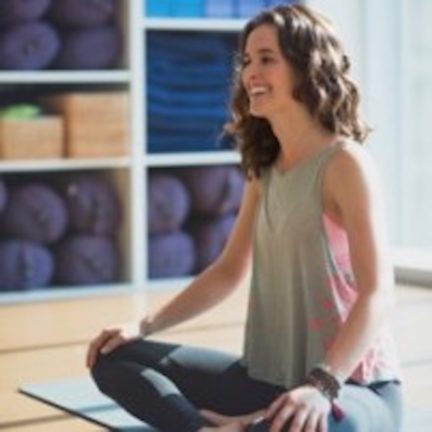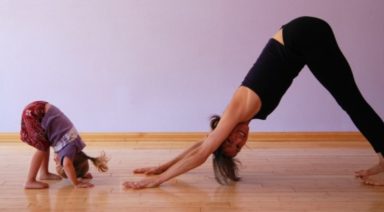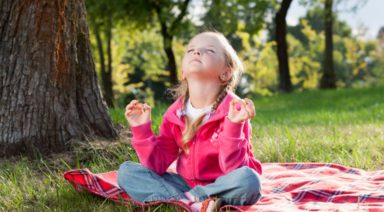Summer Solstice: Rhythm and Ritual Through Yoga

With every passing year, the world’s seasons reveal the environmental evidence of a planet that breathes. Mirroring natural periods of warming and cooling that result from our changing position relative to the sun, our living earth completes one cycle of respiration over the course of a single year.
As witnesses to this faithful pattern, we are invited to remember the intimate relationship we have with our home in the universe – each one of us embodied cosmos, completing this identical sacred cycle of birth and death with every breath. Particularly in these times of seasonal transition, may we allow ourselves to be breathed by mama Gaia, the benevolent mother earth, as we consider the seasonal progression of internal time illuminated by our own breathwave.
The Stillness of a Star: Observing a Cosmic Pause
The word solstice comes from the Latin roots sol, meaning sun, and stitium, meaning to stop or be still. With unassuming clarity, these etymological elements describe the precise moment of a solstice when our radiant solar star appears to pause in the sky as its trajectory undergoes a perceived directional shift. This cosmic pause welcomes our attention as we prepare to enter the next cycle of our planet’s breathwave.
While the perceived stopping of the sun is what defines a solstice on the basis of perception, the astronomical underpinning of such an event is actually the tilt of the earth’s axis. When our planet reaches the point along its orbit where its axial tilt is most inclined toward the sun, we experience the summer solstice. Bowing to the ultimate source of sustenance, the earth humbly receives this blessing of solar energy like a flower leaning toward the light.
On the day of the solstice, while traveling at 108,000 km/hr around our system’s center, we perceive the longest path of our sun through the sky as it arcs toward its northernmost position from the equator.
In other words, we enjoy the longest day of the year and the beginning of the summer season.
The Summer Swoon
The summer solstice celebrates the apex of light and sunshine continues to triumph over shadow during this season. Common to both ancient and modern cultures, the sundry interpretations of this celestial event underscore a deep gratitude and honoring of the earth.
Whether venerating the feminine, yin energy in Chinese tradition, hailing the rise of the brightest summer star, Sirius, in Egypt, celebrating the personified fertility goddess, Epona, in Celtic tradition, or praising the god of agriculture during Kronia in Greece, the underlying spirit of summer is one of emergence, purification and potency.
Though we may not always consciously observe these time-honored traditions in the bustle of modern daily life, there is something undeniably special about summertime, it’s the summer swoon.
From a young age, I remember equating long summer days with more freedom. With a sliding curfew that was defined by the street lights coming on, more daylight meant I stayed outside longer, swimming until my fingers were pruney and chasing lightning bugs at dusk. In my adult life, the sacred sway of summer means less hurry, less service to time and more relaxation by virtue of a generous sun that descends more slowly in the evening hours. The whole world seems to participate in this seasonal summer sigh, expanding into the light as we approach the halfway point on our journey around the sun. It is a natural time for reflection and the effortless joy that comes with living in rhythm.
Ritucharya: Attuning to Seasonal Rhythms
Integral to the Ayurvedic approach to health, ritucharya is the conscious alignment of environmentally informed practices with external seasonal rhythms (ritus). Acknowledging how the ritus were primarily influenced by the perceived path of the sun through the sky, early Vedic astronomers divided the year into two six-month periods relating to its course. As the sun moves in a northerly direction, the period of increasing light between the winter and summer solstice is called uttarayana. Uttara meaning northern and ayana meaning movement, path or direction.
Complementing uttarayana, the period of decreasing light between the summer and winter solstice, is dakshinayana, dakshina meaning southern. Delineated by the solstices, these phases or kalas also divide the year into a time of gradual energy depletion (adanakala), resulting from increased heat and dryness, and a time of energy restoration (visarga) corresponding to greater cooling and moisture.
Yoga Practice for Seasonal Transition: Vasanta to Grishma
In the northern hemisphere, the June solstice is one of four major sandhis or junctures where the seasons change, bringing spring (vasanta) to an end as summer (grishma) begins. During this time, Ayurveda prescribes a gradual shift from kapha balancing yoga practices which heat and activate to pitta pacifying practices which are cooling and regenerative.
To avoid imbalance and energetic disruption during the time of transition, practices that are appropriate in both seasons can alleviate stress by allowing the body to adapt more slowly to the change. As we continue opening in receptivity for the second half of our journey around the sun, consider the following during a period of about two weeks around the summer solstice to preserve the body’s vital essence.
Connect the fullness and upward energy of solar backbends to the stability and strength of the earth in postures like Ustrasana and Dhanurasana offered in the sequence below.
- Invite the circulation and fluidity of the water element to prevent energy stagnation by adding rhythmic movement of the limbs in static postures
- Take care not to become depleted by hydrating and staying cool during the increasingly hot and dry midday sun
- Reserve the morning and early evening hours for physical activity
- Support the body’s natural cooling process which pulls the inner digestive fire to the extremities by shifting to smaller, lighter meals
- Spend time outdoors in the evening and take in as much moonlight as possible
Summer Solstice Sequence: Moving Meditation for the Whole Body
Heart
Offer to your inner fire altar anything you wish to purify through release.
As a moving prayer, let any hindrances to transformation dissolve into emptiness, clearing the inner slate for the next season. Before beginning your moving meditation practice, read the following verse from the Vijnana Bhairava Sutra, letting the sweet words Shiva offered to his bride, Shatki, land as a soft whisper of wisdom.
“Exhaling, breath is released and flows out. There is a pulse as it turns to flow in. In that turn, you are empty. Enter that emptiness as the source of all life.”
Vijnana Bhairava Tantra, Yukti Verses I, translation by Lorin Roche
Breath
I invite you to practice this sequence with an emphasis on the emptiness of the exhale. Emerge into the potency of this void as potential for experiencing the complementary fullness of the next breath, the next pose, the next season. When it can be done without strain, observe Bahir Kumbhaka, pausing for a few moments at the end of the exhale when the lungs have emptied to experience how the direction of the breath shifts. At the close of the practice, please offer several rounds of Sitali Pranayama, a cooling breath, as needed to pacify pitta by expelling heat before relaxation.
Body
The sequence offered below begins in a seated position using rhythmic motion in the arms to trace the flow of breath in and out of the body in reverence of the internal seasons while awakening the spine. This gentle opening is followed by a slow, steady standing sequence where the lower energetic centers are activated, drawing energy towards the earth in preparation for grounding backbends. Marrying the qualities of fire and water, dynamic movement is employed in postures that stimulate the solar plexus chakra (manipura), the place where pitta resides.
Taking this fluid motion into prone backbends, the idea is to navigate the transition from the activating energy of spring to the hot, arid summer season where pitta is susceptible to aggravation. With circular movements that mirror the arc of the sun in the sky, the arms trace the line of the horizon and pause to experience the conscious, directional shift of the limbs – an interstitial gap that embodies the illusory solar stillness of the solstice.
To support your self-practice, please refer to the pose breakdown below with links to photos and alignment for each posture or enjoy the complete guided sequence video. Bows and blessings to Britt B. Steele of the Deva Daaru YogaFarm for generously offering her studio space for this practice.
Purifying Through Fire: Creating a Fire Ceremony

The ancient Vedic culture, from which yoga is derived, has a long-standing tradition of rituals designed to pay homage to and communicate with the divine. In a Puja ceremony, one makes simple offerings in gratitude for the blessings they have received and to return a piece of these gifts back to spirit. In a Yajna, the ritual is more extensive. Here Brahman or Vedic priests communicate with specific aspects of the divine through the messenger Agni, the fire God. Yajnas, as prescribed in the Vedas, follow a specific template which include intention, offerings, and specific mantras to be recited. The following article describes the basic tenants of Yajna and Puja to provide a template for practitioners to create their own fire ceremony of purification and transformation.
1. Begin in Fullness
A central tenant in yoga is the notion of “purnam” or wholeness. All that exists arises from wholeness and is in itself whole. It is essential in our communion with spirit to understand that we are not separate from and seeking union; instead we are unified and remembering.
Purnam exists throughout the entire life cycle; from the blessing of a newborn baby to the cremation grounds of Varanassi, the wholeness of life is acknowledged through its entirety. As an individual soul, or atman, we go through a journey of transformation as our life unravels to reveal new layers of understanding. Regardless of one’s disposition, place in life, failures or successes, each individual is of “purnam” and as such, divinely whole. The practice of purification serves to dissolve the illusion of separation and bring the aspirant back into their knowing of wholeness.
Application
As you prepare your body and mind for fire ceremony, do so from the intrinsic understanding that you are whole exactly as you are. Bring your whole self forward. Allow all parts of you, from the beautiful to unseemly, to open to the direction and guidance of spirit.





































